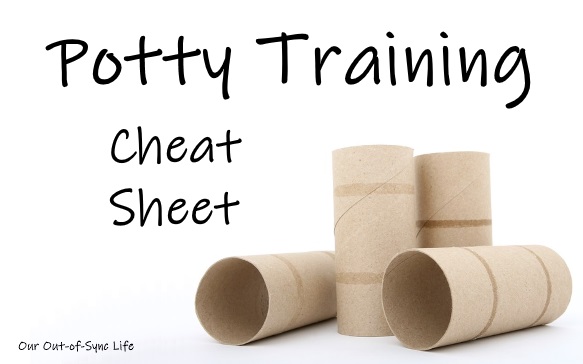So far in this series, I have shared five supplies that I feel are necessary for potty training and I have taken you through the three-step process. Today, I will begin answering your questions!

Question #1 – How do you know when your child is ready?
Figuring out the answer to this question is key. Starting too early can be frustrating on everyone. In talking to one of my friends about the subject she said, “I firmly believe that the earlier you start, the more issues there will be.” She potty trained two of her kids at 2 1/2 and had almost no issues. The attempt with her 18 month old was messy.
Here are a few “signs” that showed me that my children were ready to begin potty training.
- The child has the vocabulary to tell you he needs to go potty.
- The child begins to tell you when she needs to go potty or when she needs a diaper change. I believe this is the most important sign.
- The child begins to wake up from more and more naps dry. Some believe that children should wake up from all naps dry before starting the process. I found with my boys sleep potty training came much later than day potty training.
- The child pees while in the shower. My friend believes this is one of the signs. Not sure the medical reasoning behind it, but I found it true with my boys.
While starting too early is challenging, I also encourage you not to wait too long. Of my friends who waited until their children was three to potty train, most were faced with struggles of control. The child was old enough to turn it into a war of wills.
Question #2 – How do you get a child to go potty?
To help the child be successful, I found it very beneficial with my boys to pour warm water on their little privates. The warm water almost always made them need to urinate. The sound of running water can also help.
Peanut loved to make bubbles in the water. I had friends who put a few Cheerios in the water and encouraged their children to “sink the Cheerios.” Another idea is to put blue toilet cleaner in the water. With enough pee, it will turn green.
These are all great tips to do but the greatest thing that you can do is relax. I can not emphasize this enough. If you are feeling pressure for your child to be dry, your child will take on this tension and success will be a struggle. Unless there is a medical issue and as long as you are being consistent, your child will be potty trained before Kindergarten.
Question #3 – What if my child doesn’t want to sit on the potty when the timer beeps?
Refusing to sit on the potty is not an option in our house. This would be handled in the same manner as any disobedience.
Question #4 – What if my child doesn’t want to leave his toys to go potty?
Sometimes, we took the toy with us to the bathroom so the toy could “see” him use the potty. But if this problem consists, this is a disobedience issue. It may mean that the toy needs to be put in time out for a while.
Question #5 – We tried potty training, but my son has not been successful.
In the second post of this series, I instructed you to do something that I didn’t do myself. Oops! In Step #2, I explained the importance of not going back to diapers once potty training is started. Yet, on the first day I explained that I stopped potty training Bubs for a while because I realized he was not ready.
In cases where you realize the child is not ready – meaning that he is not having any success and only accidents – it may be best to wait a few months. When I realized this, I put away all signs of potty training (out of sight, out of mind) and focused on Step 1 only. Then several months later, I pulled out the supplies like they were brand new and we had never tried potty training before.
Question #6 – My child won’t tell me when he needs to go? I have to take him.
I believe there is a difference between the child being potty trained and the adult being potty trained. By that I mean, a child is potty trained when she feels the urge, goes to the bathroom, does her business, and comes out. The adult is potty trained when she has learned to take her child at specific intervals of the day. The ownership of the problem is complete opposite. A transition has to occur to move the responsibility from the adult to the child.
One way that I did this is to remove the reward for going potty and place the reward on taking the initiative. So, when Peanut tells me he has to go potty and runs into the bathroom, he gets a M&M. He no longer gets one just for peeing or pooping.
Well, I have filled this post with my thoughts and there are still more questions to go! So come back tomorrow to read my thoughts on the most asked question on potty training. On Friday, I will finish with your specific questions.